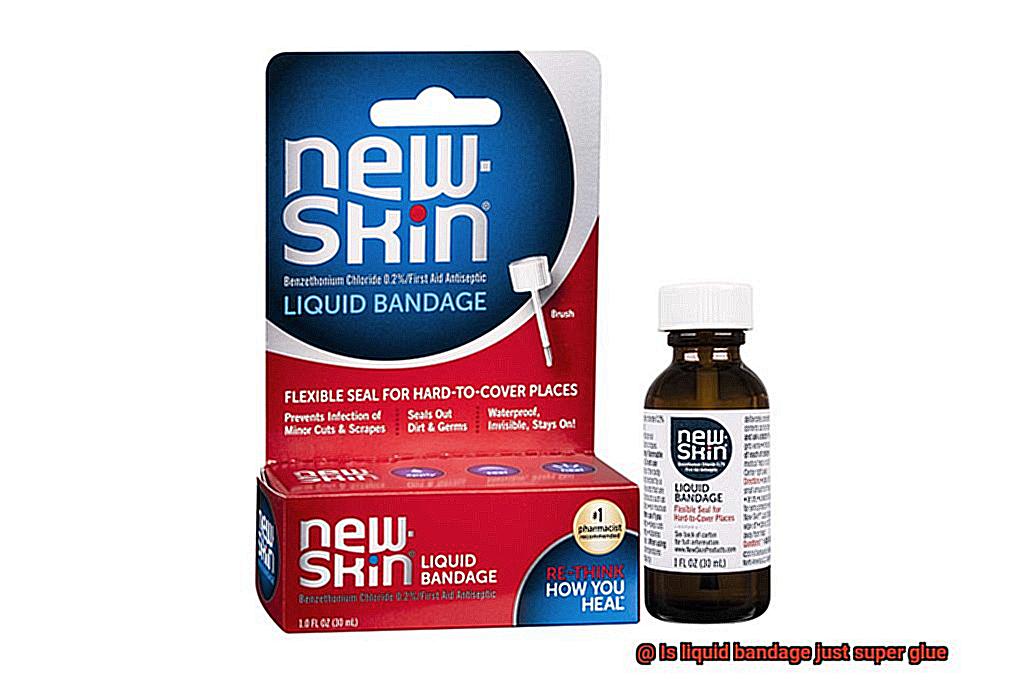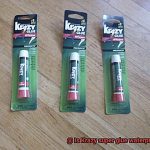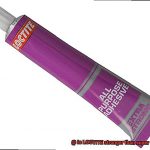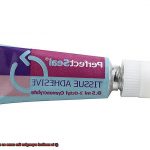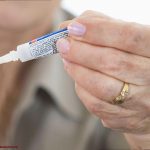Have you ever found yourself pondering the similarities between liquid bandage and super glue?
It’s a question that has crossed the minds of many, including myself. At first glance, these two products may appear strikingly similar.
Both are transparent, gooey substances that can be applied directly to wounds to create a protective seal. They both boast the ability to expedite wound healing and reduce the risk of infection.
But are they truly one and the same? In this blog post, we’ll embark on a journey into the realm of liquid bandage and super glue to unravel the truth behind their likeness and disparities.
So, grab your favorite mug of steaming coffee and prepare yourself for a deep dive into this enigmatic topic.
How Are Liquid Bandage and Super Glue Different?
Contents
- 1 How Are Liquid Bandage and Super Glue Different?
- 2 Benefits of Using Liquid Bandage Over Super Glue
- 3 Reasons to Use Super Glue Instead of Liquid Bandage
- 4 What Kinds of Wounds Can Be Sealed with Liquid Bandage or Super Glue?
- 5 Safety Considerations When Using Liquid Bandage or Super Glue
- 6 How to Apply Liquid Bandage or Super Glue Properly
- 7 Removal of Liquid Bandage or Super Glue
- 8 When to Seek Professional Medical Help Instead of Using Adhesive Substances
- 9 Conclusion
Liquid bandage and super glue may appear similar at first glance, as they are both adhesive products used to seal wounds or cuts. However, a closer examination reveals significant differences between the two. Let’s delve deeper into their composition, uses, benefits, and drawbacks to better understand how they set themselves apart.
Composition:
Liquid bandage is tailor-made for medical purposes and contains ingredients that facilitate wound healing and guard against infection. It typically incorporates a polymer like cyanoacrylate, which creates a protective seal over the wound, acting as a barrier against harmful bacteria and other microorganisms. Liquid bandage may also be enriched with additional substances such as antiseptics or antibiotics to bolster its healing properties.
Super glue, on the other hand, is primarily employed for bonding objects together. It usually comprises ethyl cyanoacrylate, an incredibly strong bonding agent that instantly forms a bond when exposed to moisture. While both liquid bandage and super glue may contain cyanoacrylate, the formulation of liquid bandage is modified to render it safe for use on skin and wounds.
Application:
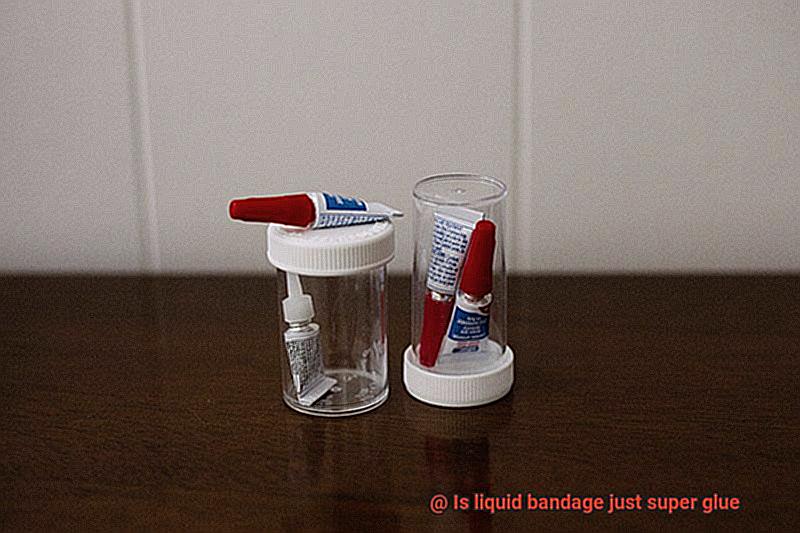
Liquid bandage is typically applied using a brush or applicator, allowing for precise and controlled application onto the wound. It dries rapidly to create a flexible and breathable film over the injury, permitting natural healing processes while providing protection.
Super glue, however, is usually applied by squeezing it directly from a tube or bottle. This method can be less precise and may result in excessive adhesive. Super glue forms a rigid bond that may not be suitable for use on areas requiring flexibility or wounds that necessitate some degree of movement.
Uses:
Liquid bandage is specifically formulated for medical use and is ideal for sealing minor cuts or abrasions on the skin. It offers a protective barrier that helps prevent infection and promotes healing. Liquid bandage can be a convenient alternative to stitches or traditional bandages for small wounds.
Super glue, however, is not intended for medical use. Its primary purpose is to bond objects together, such as metal, plastic, or ceramics. Although it may seem tempting to employ super glue to close a wound, it is not recommended as it is not designed for skin contact and may cause irritation or other adverse reactions.
Advantages and Disadvantages:
Liquid bandage boasts several advantages. It is specifically formulated for medical use, safe for skin contact, and approved by regulatory bodies like the FDA. Liquid bandage is easy to apply, dries quickly, and provides a protective barrier against infection. Additionally, it is typically easier to remove from the skin compared to super glue.
On the other hand, super glue possesses advantages in terms of its strong bonding properties and fast-drying nature. It is ideal for bonding objects together quickly and securely. However, its disadvantages include the potential for skin irritation or adverse reactions when used on wounds. Super glue is not designed for skin contact and may impede natural wound healing processes.
Benefits of Using Liquid Bandage Over Super Glue
When it comes to minor cuts or wounds, we all want a quick and effective solution. While super glue may seem like a tempting option, liquid bandage offers a range of benefits that make it the superior choice for wound care.
In this blog post, we will delve into the advantages of using liquid bandage over super glue, exploring its flexibility, breathability, waterproofing properties, ease of application, and safety for use on sensitive areas.
Flexibility:
Liquid bandage is a true superhero when it comes to flexibility. Unlike super glue that hardens into a rigid substance, liquid bandage moves with your skin, providing comfort and preventing discomfort in areas that require flexibility, such as joints or bending-prone areas.
Breathability:
Proper healing requires air circulation, and liquid bandage allows just that. Its breathable formulation allows air to pass through the applied area, promoting optimal healing conditions by preventing moisture buildup that can lead to infection. Super glue, on the other hand, forms an impermeable barrier on the skin, hindering the healing process.
Waterproofing:
Liquid bandage is not only flexible and breathable but also water-resistant. Once dried, it creates a waterproof seal that protects the wound from water and moisture. Whether you’re swimming or taking a shower, liquid bandage remains intact, ensuring that your wound stays protected.
Super glue lacks this waterproof property and may lose its adhesive strength when exposed to water.
Ease of Application:
Say goodbye to messy and complicated application processes. Liquid bandage comes in user-friendly applicator bottles with brush tips or spray forms. Applying it directly to the affected area is a breeze – no additional tools or equipment required. On the contrary, super glue typically comes in small tubes and necessitates precise application using separate tools like cotton swabs or toothpicks. This can prove challenging, especially for hard-to-reach areas or small cuts.
Safe for Use on Sensitive Areas:
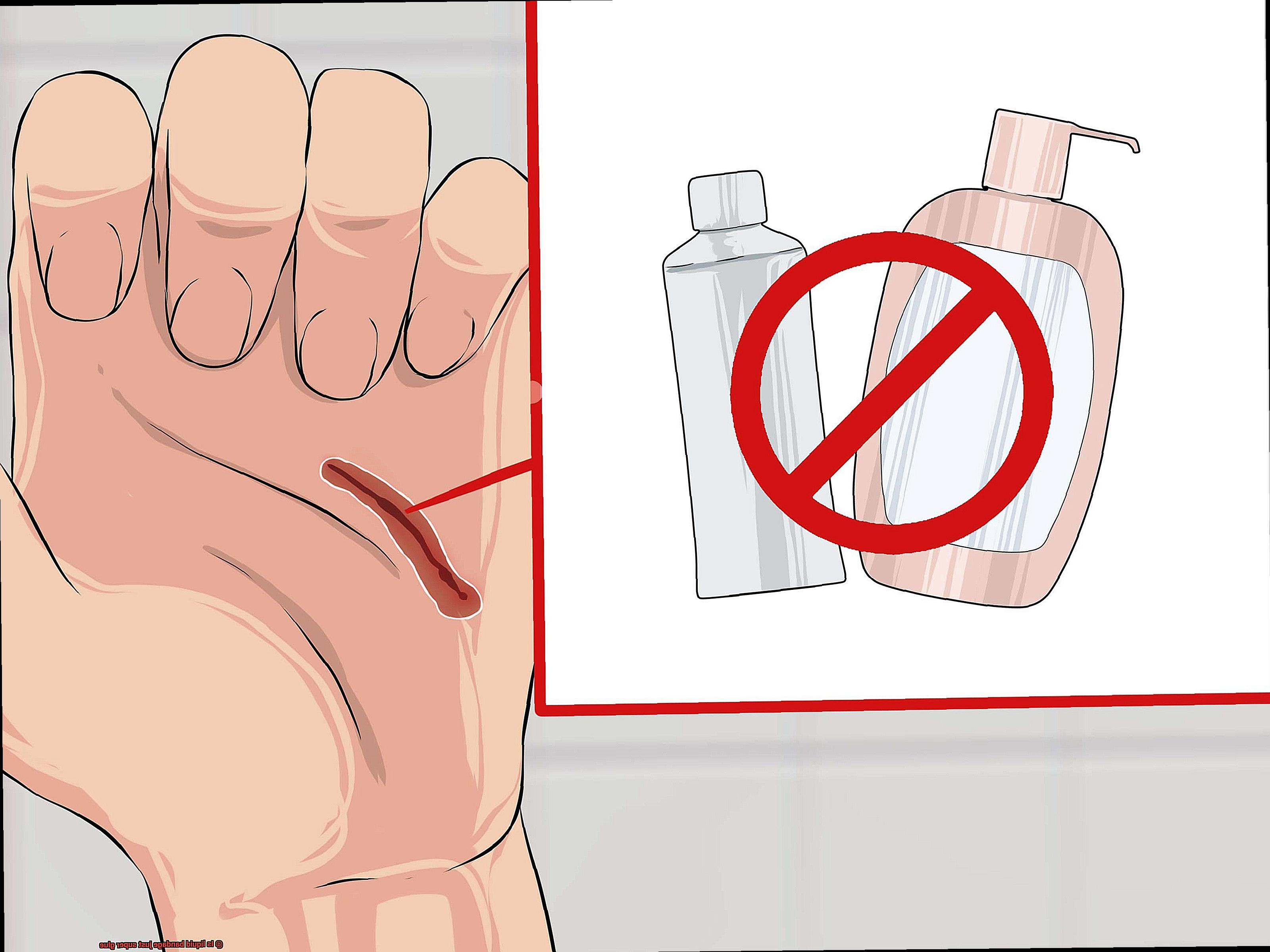
Liquid bandage is a gentle hero that is safe for use on sensitive areas, such as the face and around the eyes. Its specially formulated composition minimizes the risk of irritation or allergic reactions. Conversely, super glue is not intended for skin application and can cause severe burning sensations, irritation, or allergic reactions in sensitive areas.
Reasons to Use Super Glue Instead of Liquid Bandage
Well, wonder no more. In this article, we’ll explore the exciting world of super glue and discover why it can be a great option for sealing those pesky nicks and scratches. So, let’s dive in.
Lightning-Fast Drying Power:
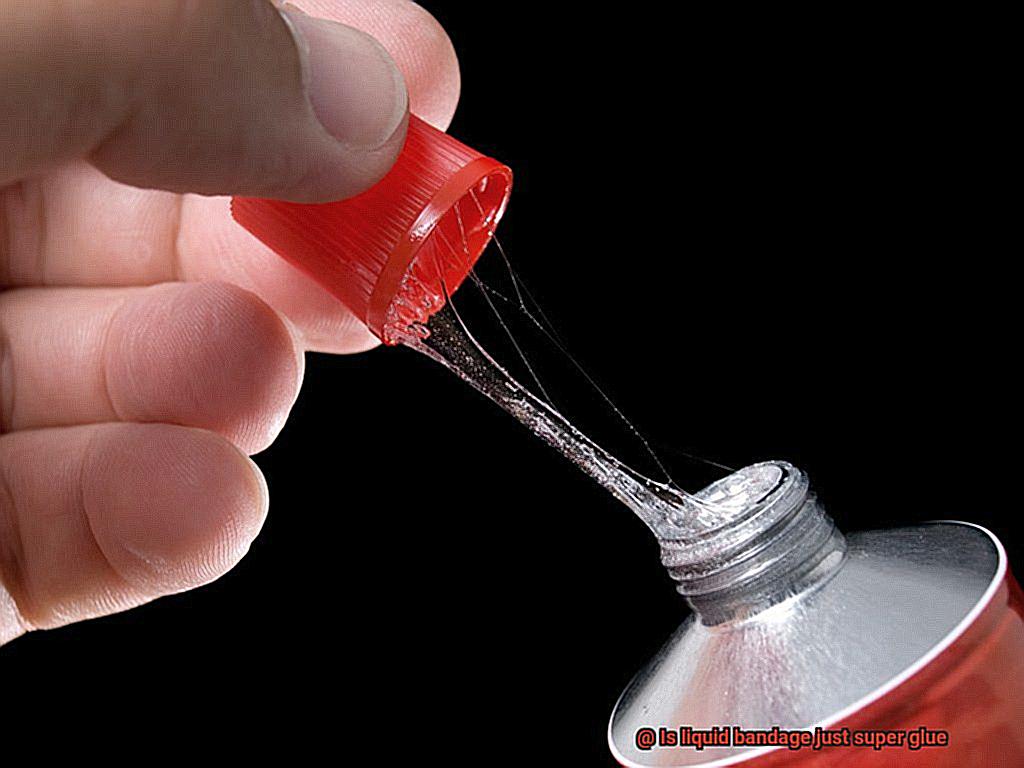
Picture this: you’re in the middle of an adventure, and you accidentally get a little scrape. You need something that dries super fast, right? That’s where super glue comes to the rescue. Unlike liquid bandage, which may take a while to dry, super glue sets in seconds. That means you can get back to having fun without worrying about your cut.
Super glue, also known as cyanoacrylate adhesive, is a superhero for your skin. Once applied, it creates an instant bond that dries rapidly. Liquid bandages, on the other hand, can take longer to dry, leaving you waiting impatiently for them to form a protective seal. With super glue, there’s no need to wait around. Its lightning-fast drying power ensures that you can continue with your activities without any interruptions.

A Bond That Doesn’t Break:
Imagine this scenario: you’ve sealed your wound with a liquid bandage and are going about your day when suddenly, it starts peeling off. Frustrating, isn’t it? That’s where super glue shines. Once applied, it forms a bond that can withstand all sorts of challenges. Whether you’re washing your hands vigorously, taking a refreshing shower, or even doing some wild dance moves at a party, super glue has got your back.
Super glue creates a durable and long-lasting hold on your skin. It forms a waterproof and flexible seal that stays put, even in high-movement areas. Liquid bandages, on the other hand, may not provide the same level of adhesion. They can peel off or wear away more easily, compromising the protective barrier and potentially delaying the healing process. With super glue, you can rest assured that your wound is securely sealed and protected.
Wallet-Friendly Wonder:
Let’s talk about money for a moment. Super glue is not only super effective but also super affordable. You can find it at hardware stores or pharmacies without breaking the bank. Plus, a little goes a long way – one small bottle can last for multiple applications. Liquid bandages may cost more and come in smaller quantities, making super glue a budget-friendly choice.
When it comes to cost-effectiveness, super glue takes the trophy. It’s a wallet-friendly wonder that delivers excellent results without emptying your pockets. You can purchase a small bottle of super glue at an affordable price, and since only a small amount is needed for each application, it lasts for multiple uses. On the other hand, liquid bandages may be pricier and come in smaller quantities, leading to more frequent purchases and higher expenses.
Versatile and Handy:
Did you know that super glue has many other cool uses? It’s not just for cuts and wounds. You can also use it to fix broken toys or even create awesome crafts. Super glue is like a magical tool that every DIY enthusiast should have in their toolbox. It’s versatile, handy, and ready to save the day.
Super glue is not limited to wound care alone – it’s a versatile adhesive that can be used for various purposes. Whether you need to repair a broken toy, mend a cracked object, or create unique crafts, super glue is there to lend its bonding powers. Its versatility makes it an essential tool for any DIY enthusiast or handyman. So, next time you have a cut, don’t forget that super glue can do more than just seal wounds.
What Kinds of Wounds Can Be Sealed with Liquid Bandage or Super Glue?
When it comes to wound closure, liquid bandage and super glue have emerged as popular options due to their convenience and effectiveness. However, it is essential to understand the specific types of wounds that can be safely sealed with these products. In this article, we will delve into the world of wound care and explore the various wounds that can be effectively sealed with liquid bandage or super glue.
Liquid Bandage: Your Skin’s Shield
Liquid bandage, also known as skin adhesive or liquid stitches, is a medical adhesive designed to close small cuts, wounds, and incisions on the skin. It acts as a protective barrier while allowing the wound to heal and preventing dirt, bacteria, and water from entering. Here are some of the wounds that can be successfully sealed with liquid bandage:
- Superficial Cuts: Liquid bandage is ideal for minor cuts such as paper cuts, kitchen knife cuts, or shaving nicks.
- Abrasions: If you have scraped your skin against a rough surface, liquid bandage can provide a protective barrier that helps prevent infection.
- Lacerations: Small lacerations that do not require stitches or sutures can be easily sealed with liquid bandage.
- Surgical Incisions: After minor surgical procedures where stitches are not necessary, liquid bandage can aid in the healing process.
Super Glue: An Alternative Solution
Although not specifically designed for medical purposes, super glue can be used under certain circumstances for wound closure. Here’s what you need to know:
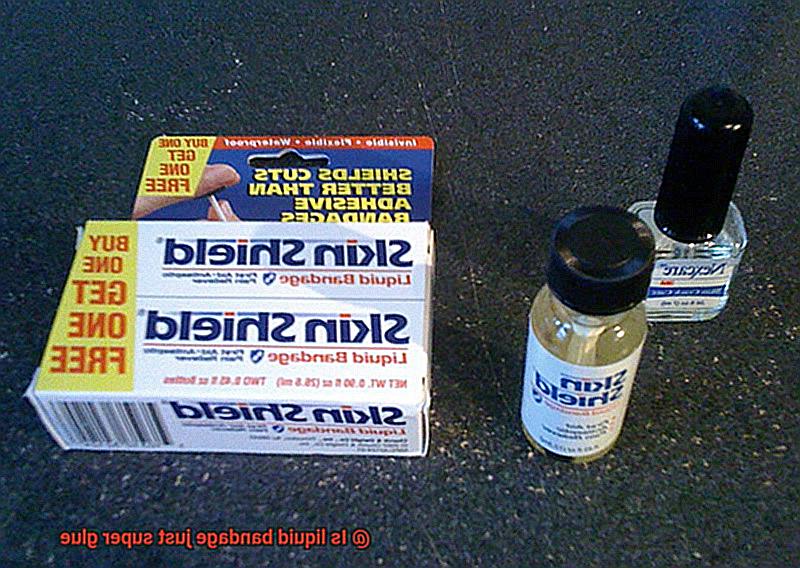
- Small Cuts and Incisions: In situations where traditional methods like stitches or staples are not readily available or feasible, super glue can provide a temporary solution.
- Clean and Superficial Wounds: Super glue should only be used on wounds that are not too deep and do not involve sensitive areas or major blood vessels.
- Caution is Key: Always exercise caution when using super glue for wound closure. It should never be used near the eyes, mouth, or other mucous membranes.
Liquid bandage and super glue can both be effective in sealing wounds, but it is crucial to understand their limitations and appropriate usage.
Liquid bandage is specifically designed for medical purposes and is recommended for superficial wounds that do not require stitches. Super glue, while not intended for medical use, can be used in certain circumstances on clean and superficial wounds
However, it is always advisable to consult a healthcare professional for proper wound care and treatment guidance.
Safety Considerations When Using Liquid Bandage or Super Glue
When it comes to minor cuts and scrapes, liquid bandage and super glue offer quick and convenient solutions for wound closure. However, ensuring safety is paramount when using these products. In this article, we will explore crucial safety considerations to keep in mind and provide a comprehensive guide on the safe usage of liquid bandage and super glue.
Patch Test:
Before applying liquid bandage or super glue to a larger area of the skin, it is vital to conduct a patch test. Apply a small amount of the product on a clean patch of skin and observe for any signs of redness, itching, or discomfort. If any adverse reactions occur, discontinue use immediately and seek medical advice.
Thorough Wound Cleaning:
Thoroughly cleanse the wound with mild soap and water before applying liquid bandage or super glue. This step helps to eliminate dirt and debris, minimizing the risk of infection. Note that deep or puncture wounds may require professional medical attention.
Avoid Eye Contact:
Liquid bandage and super glue should never come into contact with the eyes as they can cause severe irritation and eye damage. If accidental contact occurs, promptly flush the eyes with clean water and seek immediate medical attention.
Ensure Adequate Ventilation:
Both liquid bandage and super glue emit fumes that may cause irritation if inhaled in large quantities. Use these products in a well-ventilated area or consider wearing a mask during application. Individuals with respiratory conditions or sensitivities should exercise caution or explore alternative wound closure methods.
Allergic Reactions:
Certain individuals may be allergic to specific ingredients present in liquid bandage or super glue, such as cyanoacrylate. Check product labels carefully and consult a healthcare professional if you have known allergies or sensitivities. Seek immediate medical attention if you experience redness, swelling, itching, or difficulty breathing after applying either product.
Proper Storage and Disposal:
To maintain effectiveness and prevent accidents, store liquid bandage and super glue appropriately. Keep them out of reach of children and pets. When no longer needed or expired, dispose of them in accordance with local regulations. Do not pour them down the drain or discard them with regular trash.
How to Apply Liquid Bandage or Super Glue Properly
When it comes to minor cuts, wounds, or small repairs, knowing how to apply liquid bandage or super glue properly can make a significant difference. In this guide, we will discuss the similarities and differences between these two products and provide step-by-step instructions on their proper application.
Liquid Bandage: Healing Wounds
Liquid bandage is a specialized adhesive that creates a protective barrier over minor cuts, scrapes, and wounds. It not only seals the injury but also promotes healing by keeping out dirt and bacteria. Here’s how to apply liquid bandage properly:
Clean the area:
Begin by gently cleaning the wound with mild soap and water. Pat dry with a clean towel or let it air dry completely.
Apply a thin layer:
Shake the liquid bandage bottle well to ensure proper mixing. Use the applicator or a clean cotton swab to apply a thin layer of liquid bandage over the entire wound, ensuring complete coverage.
Allow it to dry:
Let the liquid bandage dry completely before applying additional layers if necessary. This may take a few minutes. During this time, avoid touching or disturbing the area.
Keep it dry:
Once applied, keep the treated area dry for at least 24 hours to allow proper healing. Avoid exposing it to water or moisture that could compromise its effectiveness.
Precautions:
- Do not use liquid bandage on deep wounds, infected areas, or burns.
- Avoid contact with eyes, mouth, or open wounds.
Super Glue: Quick Fixes
Super glue is a versatile adhesive known for its fast-drying properties and strong bond. While not intended for skin use, it can be temporarily applied to small cuts or skin tears until proper medical attention is obtained. Follow these steps:
Clean the area:
Clean the affected area with mild soap and water, ensuring it is completely dry before applying super glue.
Apply a small amount:
Use caution when using super glue on skin. Apply a small drop of super glue to the edges of the cut or tear. Gently press the skin together, holding it in place for a few moments until the glue sets.
Avoid healthy skin and clothing:
Take care to avoid getting super glue on healthy skin or clothing. If needed, protect the surrounding area with a barrier, such as petroleum jelly.
Precautions:
- Super glue should never be used on deep wounds or open skin.
- Seek professional medical help for more severe injuries.
Removal of Liquid Bandage or Super Glue
We’ve all encountered minor cuts or quick fixes that call for the use of liquid bandage or super glue. While these adhesives are incredibly useful, removing them can sometimes be a challenge. Fear not. In this article, we will explore the differences between liquid bandage and super glue, and provide you with foolproof methods for their safe removal.
Liquid Bandage vs. Super Glue:
Liquid bandage is specifically designed for minor cuts and wounds. Its formula creates a flexible and breathable protective layer, allowing your skin to heal while preventing bacteria from entering the wound.
Super glue, on the other hand, is a versatile adhesive used for bonding various materials like plastic, metal, or wood. It forms a strong and rigid bond that is ideal for repairs.
Removal Methods for Liquid Bandage:
Removing liquid bandage is a straightforward process. Begin by soaking the affected area in warm soapy water. This will help loosen the adhesive. Gently rub the area with a soft cloth or cotton ball to aid in the removal of any remaining residue.
Remember to avoid harsh chemicals or abrasives that could further irritate your skin.
Removal Methods for Super Glue:
Removing super glue requires a bit more effort due to its strong bond. If it has adhered to your skin or fabric, reach for an acetone-based nail polish remover. Apply it gently, allowing it to dissolve the glue.
However, exercise caution as acetone may cause skin irritation. For delicate surfaces like electronics or glass, consider using specialized adhesive removers or scraping tools designed for these materials.
Precautions and Safety Measures:
When removing liquid bandage or super glue, always follow instructions carefully. If necessary, wear protective gloves to avoid any adverse reactions. If you encounter any complications during the removal process, seek medical advice promptly.
When to Seek Professional Medical Help Instead of Using Adhesive Substances
Adhesive substances like super glue and liquid bandage have gained popularity as quick fixes for minor cuts and wounds. While they can be effective in certain situations, it is important to understand when seeking professional medical help is necessary.
This article will explore the circumstances that warrant medical advice and provide examples of when adhesive substances are not appropriate solutions.
Severity of the injury:
- Deep wounds, gaping cuts, or profuse bleeding require immediate medical attention as adhesive substances may not provide sufficient closure or effectively stop the bleeding.
- Examples: A deep laceration from a kitchen knife, a wound caused by a rusty object, or a large abrasion resulting from a fall.
Location of the injury:
- Sensitive areas like the face, hands, feet, or joints demand specialized care to ensure proper healing and minimize complications.
- Examples: A facial cut near the eye, a hand wound requiring precise alignment for optimal function, or a foot wound prone to infection due to exposure to dirt and bacteria.
Underlying health conditions:
- Individuals with diabetes or compromised immune systems have impaired wound healing abilities and should seek medical help to ensure appropriate treatment and prevent complications.
- Examples: A diabetic with an ulcer, a person with HIV/AIDS with an open sore, or someone undergoing cancer treatment with fragile skin.
Signs of infection:
- If the wound shows signs of infection such as increased pain, redness, swelling, warmth, pus, or fever, it is crucial to seek medical attention promptly.
- Examples: A wound becoming increasingly painful and red after applying adhesive substances or a cut that develops pus and emits an unpleasant odor.
Adhesive substances as secondary treatment:
- Adhesive substances should never replace professional medical care but can be used as temporary measures until proper medical attention is available.
- Examples: Using liquid bandage to temporarily seal a small cut before visiting a doctor or using super glue to hold a wound together until reaching an emergency room.
F46t731hTmg” >
Conclusion
The conclusion of this investigation is clear: liquid bandage is not just super glue. While both substances may share some similar properties, such as adhesive capabilities, they are distinctly different in their composition and intended use.
Liquid bandage is specifically formulated for medical purposes. It contains ingredients like cyanoacrylate, which forms a protective barrier over wounds to promote healing and prevent infection. This specialized formulation ensures that the liquid bandage remains flexible, breathable, and safe for use on the skin.
On the other hand, super glue is designed for general purpose bonding. It typically contains ethyl 2-cyanoacrylate, which creates a strong bond between surfaces. However, super glue lacks the necessary qualities to be used as a medical adhesive. It can be toxic to the skin and does not provide the same level of flexibility and breathability as liquid bandage.
In summary, while liquid bandage and super glue may appear similar on the surface due to their adhesive properties, they are fundamentally different products with distinct purposes. Liquid bandage offers a safe and effective solution for minor cuts and wounds, while super glue should strictly be reserved for non-medical applications.
By understanding these differences, individuals can make informed decisions about which product to use in various situations.

